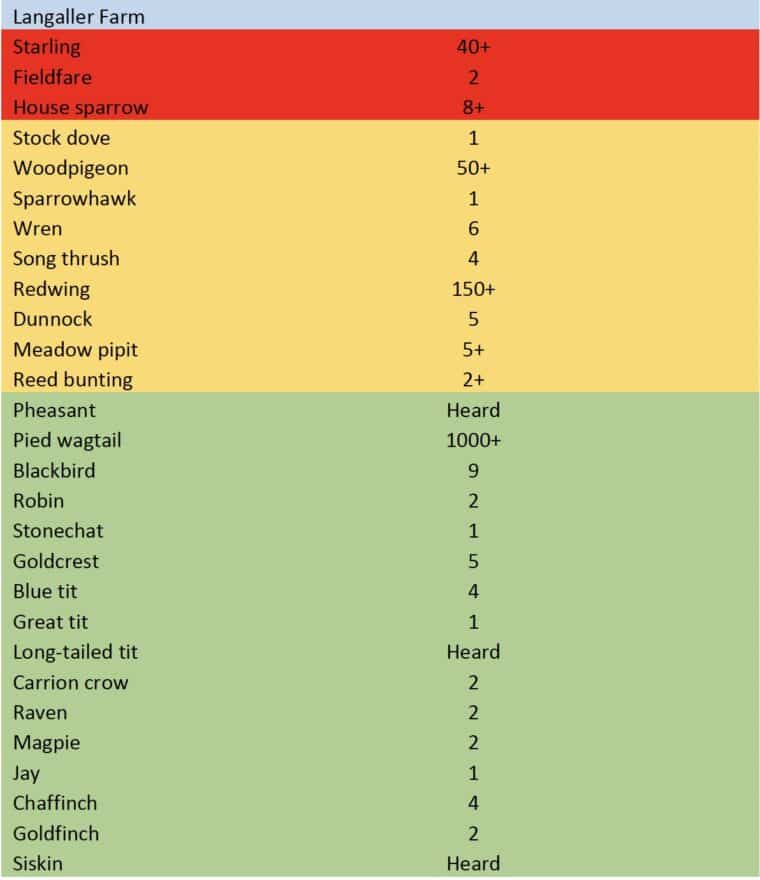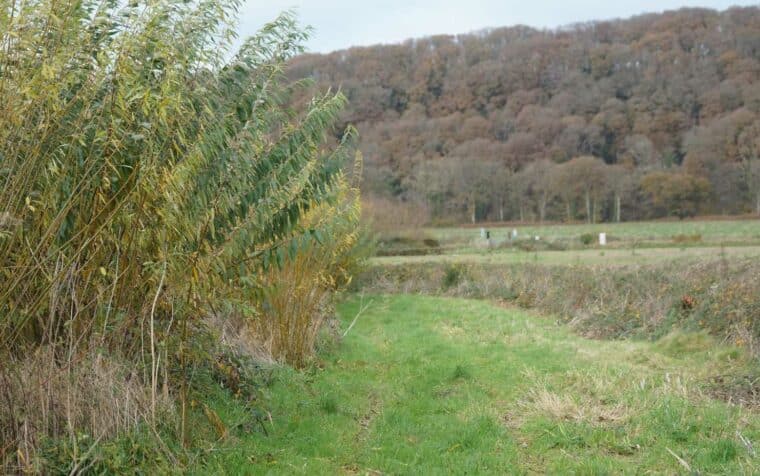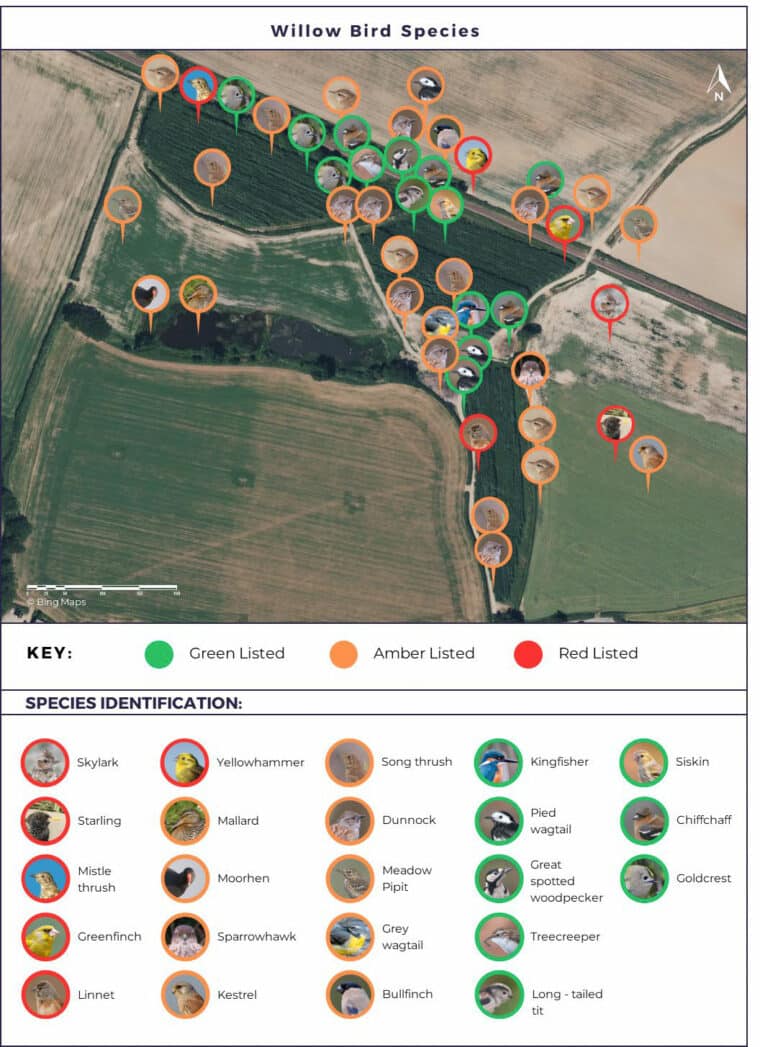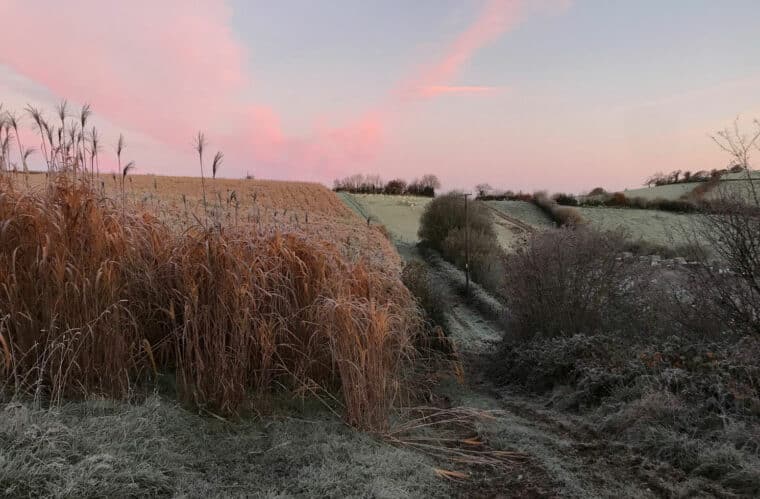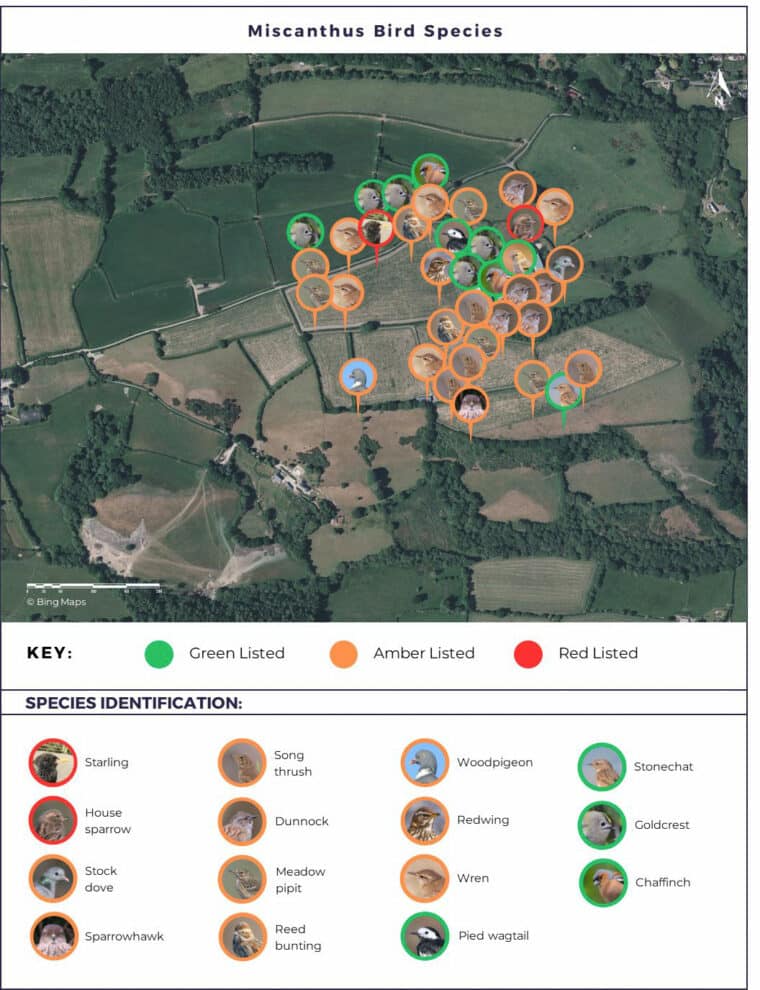Field Report: Comparing bird communities in willow and Miscanthus crop fields – SPRING 2024 SURVEY
Background
This field report follows on from the previous winter bird surveys1 conducted at two farms, one in Devon and the other in Somerset. One farm had a mixed age willow crop, while the other had a Miscanthus crop. This field report covers bird surveys repeated at these farms in spring, and two additional single surveys undertaken at new locations with willow and Miscanthus. The aim of these ongoing surveys is to record and map the birds seen through the seasons to see what benefits each crop may have for different species.
The full rationale and method are given in the winter field survey. Briefly, the Common Bird Census (CBC) method (Williamson & Homes 1964)2 was followed. This is based on a territory-mapping approach, which involves recording all contacts with birds (by sight or sound) on a map of a defined area, during a series of visits throughout the breeding season. Birds were recorded within a 250-metres buffer zone of the two crops.
Results
The birds recorded have been colour-coded depending on their conservation status in the UK (red, amber or green). Those in red have the most conservation concern while those in green have the least. Some species such as woodpigeon and wren are amber listed due the UK having a significant proportion of Europe’s population.
For more information see: bto.org/our-science/publications/birds-conservation-concern3.
Langaller Farm [Miscanthus]:
On the 13th and 14th March 2024, Ed Drewitt and Kevin Lindegaard walked the fields at Langaller Farm containing Miscanthus. On the 13th March an afternoon (14:00-17:00) survey was conducted followed by a morning (8:30-10:30) survey on the 14th March. The weather was sunny spells with excellent visibility and highs of 12°C and lows of 9°C
Across the survey area, 26 bird species were recorded of which ten are amber listed and three are red listed. Only four species were seen in or on the edge of the Miscanthus: blackbird, dunnock, wren and reed bunting.

Table 1: A summary of the bird species recorded on or over Langaller Farm (Miscanthus crop). Red = red listed; orange = amber listed; green = green listed. Those marked with an asterisk (*) were recorded in the crop itself.

Figure 1: A map showing where a selection of bird species was seen or heard at Langaller Farm (Miscanthus crop). Red = red listed; orange = amber listed; green = green listed.
The highest diversity of bird species was in the woodland close to the farm before reaching the Miscanthus fields. This is likely to be due to better feeding opportunities and nesting habitats. The ancient hedgerows which border the Miscanthus at Langaller Farm were remarkably quiet, which may have been due to the time of the year with some species on nests and less likely to be singing and winter migrants having departed. Chiffchaff was recorded singing in the woodland. Although away from the immediate fields, a flock of over 40 rooks were foraging in the nearby grazing fields.
Umberleigh Barton Farm [SRC willow]:
On the 14th and 15th March 2024, Ed Drewitt and Kevin Lindegaard walked the fields containing short rotation coppice (SRC) willow. On March 14th an afternoon (13:15-15:30) survey was conducted followed on the 15th by a morning (8:15-10:30) survey. The weather was a mix of sunny spells and very heavy rain, with highs of 11°C and lows of 9°C.
Thirty-one bird species were recorded of which thirteen are amber listed and three are red listed. Of these, eight species were seen in or on the edge of the willow: blackbird, song thrush, reed bunting, dunnock, wren, blue tit, long-tailed tit and chiffchaff.

Table 2: A summary of the bird species recorded on or over Umberleigh Barton Farm (willow crop). Red = red listed; orange = amber listed; green = green listed. Those marked with an asterisk (*) were recorded in the crop itself.

Figure 2: A map showing where a selection of bird species was seen or heard at Umberleigh Barton Farm (willow crop). Red = red listed; orange = amber listed; green = green listed.
Although fewer species were recorded than in December, mid-March is a period when winter migrants are leaving and spring migrants are only just beginning to trickle in. Chiffchaff was commonly singing in the trees adjacent to the willow while at least one was foraging amongst the willow branches and emerging leaves. Chiffchaffs had just arrived from wintering in the Mediterranean. Long-tailed tits were feeding and moving through the willow, while blue tits were feeding amongst the catkins. The reed bunting flew across from the ponds to the edge of the willow. Blackbirds and song thrushes were generally observed at ground level or flying away from the edges of the willow.
Most birds were sighted or heard in the areas of oak trees and young woodland by the railway, that are adjacent to the willow plantations. As with the experience at Langaller Farm, the hedgerows themselves were quiet and may have been due to the time of the year. Some species, such as blackbirds, robin and song thrushes may have already been on eggs or have chicks and therefore were less likely to be singing and therefore detectable. We also had some heavy, driving rain, which suppressed bird activity. On the farm ponds, little grebe, coot, moorhen and mute swans were also noted.
Additional sites visited
A week later there was an opportunity to visit two further sites in the West Midlands. This offered the chance to see if there was consistency with the results gathered from the sites in the south west.
The Fold, Bransford [SRC willow]
On the 20th March 2024, Ed Drewitt and Kevin Lindegaard walked the fields containing SRC willow (9:40am – 11:40am). The weather was sunny and calm, with highs of 16°C and lows of 12°C.
Twenty-three bird species were recorded of which nine are amber listed and one is red listed. Of these, five species were seen in or on the edge of the willow: song thrush, reed bunting, blue tit, great tit and chiffchaff.

Table 3: A summary of the bird species recorded on or over The Fold. Red = red listed; orange = amber listed; green = green listed. Those marked with an asterisk (*) were recorded in the crop itself.

Figure 3: A map showing where a selection of bird species was seen or heard at The Fold (willow crop). Red = red listed; orange = amber listed; green = green listed.
The highest diversity of bird species was along the hedge and tree line separating the two fields of willow and along the north-east edge by the river. The field to the east was most active with birds: great tits, blue tits and chiffchaffs were moving between the willow stands and the trees along the hedge line. A song thrush was singing in the older stand of willow in this field. A reed bunting was calling from the younger stand in this field. The field to the west was less busy with birds; those seen (woodpigeon and carrion crow) were using the wide-open strips between the willow. Both green and great spotted woodpeckers were using the larger ash trees by the river and the hedgerow separating the two willow fields.
Wenlock Spring [Miscanthus]
On the 20th March 2024, Ed Drewitt and Kevin Lindegaard walked the fields containing Miscanthus (14:00 – 15:45). The weather was overcast followed by heavy rain, with highs of 13°C and lows of 10°C.
Twenty-two bird species were recorded in the survey area of which five are amber listed and one is red listed. However, aside from pheasant, none of these species were recorded in or on the edge of the Miscanthus. While the Miscanthus itself was almost devoid of birds, the northern Miscanthus field was being used by several brown hares.

Table 4: A summary of the bird species recorded on or over Wenlock Spring. Red = red listed; orange = amber listed; green = green listed. Those marked with an asterisk (*) were recorded in the crop itself.
The highest diversity of bird species was in and along the edge of the ancient woodland by the Miscanthus, on the south-side of the factory. In particular, an uncut hedgerow, running along the south-west edge of the southern left-hand Miscanthus field was busy with robins, wrens, blue tits, goldcrest and chiffchaff. Skylarks were singing in the open fields adjacent to the northern field of Miscanthus. Along the edge of the stream, adjacent to the southern left-hand Miscanthus field, there was a large patch of primroses. These were perhaps original and wild and were providing opportunities for early pollinators to feed.
Conclusions
As previously found in the winter survey of Umberleigh Barton and Langaller Farms, the willow plantations appear to be supporting more bird species than Miscanthus in the spring, probably because it is a better food plant for wildlife and therefore is an important and integral part of the mosaic environment on these farms.
At The Fold, the willow plantation on the east side of the site supported a small range of species. In particular, the great tits, blue tits and chiffchaffs appeared to be feeding amongst the newly emerged leaves in the more mature parts of the plantation. A song thrush was also singing in this older stand, suggesting it had a territory and most probably a nest in this area of willow. The willow in the west field was much younger and in less good health. This was unused by birds – apart from wide, open gaps between the planting – in contrast to the more mature and mixed-type plantation in the east field. However, even here, most bird life was in the adjacent and surrounding hedgerows and woodland.
The Miscanthus fields at Langaller Farm appear to support a relatively low number of bird species and those at Wenlock Spring appear to support none or a low number of bird species. In both places, birds were using the adjacent hedgerows and woodland.
Like the winter survey, the spring surveys were just a snapshot of birds heard or seen on these days. Further surveys over a longer period of time would be required to acquire a more robust set of data that can be compared statistically. These surveys do however provide some developing insights and comparisons that may provide further rationale for gathering further evidence and information in the future.
General Recommendations
- It is important to provide a greater range of both spring and summer flowering wildflowers. While there is a lot of focus on planting wildflowers that bloom in the summer (June/July) on farms, there is frequently an absence of flowers, and therefore food, for early emerging insects in March/April. To provide early spring food for pollinators and other inverts, early flowering plants such as primroses, cowslips, lesser celandines and cuckoo flowers can be added. Allowing dandelions to flower and seed is important both for pollinators and finches, at a time when natural food (in April and early May) has run low. Encouraging local sallow (or pussy willow) to grow further will provide one of the best early flowers for early emerging pollinators such as queen bumblebees and also provide nectar for birds such as chiffchaffs, blackcaps and blue tits. Summer meadow wildflowers could include black and greater knapweed, red and white clover, bird’s-foot trefoil, yarrow, field scabious, betony and oxeye daisies.
- Areas of fields with awkward shapes or edges could remain unsprayed by herbicide allowing herbs and flowers such as dandelions to grow and provide food for wildlife.
- Creation of wider margins would allow space for native plants to grow and provide some buffer between the hedgerows and the Miscanthus This should be up to 2 metres between the crop and the hedgerows.
- The hedgerows could be left uncut for several years, and then cut on rotation (or left entirely) to allow the hedgerows to provide more cover and food for pollinators and insects for birds; in particular, leaving them uncut will allow hawthorn and blackthorn to flower (following a cut hawthorn will not flower until the second spring) and generally provide a better habitat for wildlife.
- Increase connectivity between hedgerows by planting more hedgerows across field margins (that perhaps once had them in the past). Where a field is adjacent to a water body, adding a hedgerow, copse or buffer strip of SRC willow can further reduce the likelihood of nutrients moving between the field and the water, reducing even small amounts of eutrophication.
- The timing of the harvests ideally needs to be done out of the bird breeding season (for example, October to February) to avoid nesting thrushes and other birds, such as robins, losing their eggs or chicks. However, we recognise that there is a next best harvest window (August to September) and a less favoured option March to July.
- Bird and bat boxes could be placed on some trees to provide further opportunities for these animals to roost or nest respectively. Ideally the bird and bat boxes should be faced on the west or north side of a tree (so the inside of the boxes do not get too hot during mid-summer). On private land, bird boxes can be put at chest height (higher if members of the public may be passing through and may interfere with them). Bat boxes can be ladder height (top of a single rung).
Photo Credits
Photo credits for Figure 1 – 5
Photos from Flickr (CC BY 2.0): chaffinch by Alan Cleaver; chiffchaff, great spotted woodpecker, house sparrow, long-tailed tit, siskin, stonechat, treecreeper and wren by Caroline Legg; reed bunting by Gérard Meyer; woodpigeon by Ian Preston; skylark by Imran Shah; goldcrest by Jo Garbutt; dunnock and linnet by Nick Goodrum; grey wagtail by Nigel Hoult; meadow pipit by Ron Knight; mistle thrush by Sudge 9000. Photo from Flickr (CC0): pied wagtail by Wildlife Terry; lesser black-backed gull by Blondinrikard Froberg; pheasant by Mark Gunn. Photos from Wikimedia Commons: magpie by Ross; grey heron by Andreas Trepte; Canada goose by Joe Ravi; coot by Rhododendrites; gold finch by David Friel; buzzard by Charkes Sharpe. Photos from Pexels: Redwing by Denitsa Kireva; chaffinch by Phil Mitchel. Photos from Animalia: common snipe by Kalle Gustafsson; green woodpecker by Hedera Baltica; red kite by Tim Felce. Photo from Geograph: cormorant by Mat Fiscione.
Other photos: mallard, moorhen and blue tit by Ed Drewitt, dunnock on cover from Adobe Stock.
Satellite images used courtesy of Bing Maps.
References
- https://www.biomassconnect.org/technical-articles/field-report-comparing-bird-communities-in-willow-and-miscanthus-crop-fields/
- https://www.tandfonline.com/doi/abs/10.1080/00063656409476073
- https://www.bto.org/our-science/publications/birds-conservation-concern
Latest Technical Articles
Field Report: Comparing bird communities in willow and Miscanthus crop fields
Introduction
This report outlines a three-day bird survey conducted at two farms, one in Devon and the other in Somerset. One farm had a mixed age willow crop, while the other had a miscanthus crop. The aim of the surveys was to record and map the birds seen at each farm to see what benefits each crop may have for different species.
Rationale
Willow and miscanthus are fast-growing crops with a wide range of uses including biofuels. A recent meta-analysis of published scientific papers has shown that the planting of non-food biofuel crops (such as willow, poplar and miscanthus) in areas that were previously arable crops or grassland has a positive effect on bird, invertebrate and plant populations alongside soil microbes (Donnison et al. 2021). There were particularly strong benefits when arable land was converted to biomass crops. Studies in the UK are often limited and focus on younger, establishing crops of Miscanthus (Semere & Slater 2007, Bellamy et al. 2009, Bright et al. 2013). However, studies on willow crops do often reflect how they appeal to different bird populations during different seasons and at different stages of crop rotation (Anderson et al. 2004, Sage et al. 2006, Fry & Slater 2011).
Method
I made single dawn (7:30am to 9:30am) and dusk (2:30pm to 4:30pm) winter visits to one farm with a willow crop and another with a miscanthus crop:
- The mixed variety willow crop covers 3.95 hectares on Umberleigh Barton Farm, aworking mixed farm based in North Devon. It was planted in 2015 and supplies abiomass boiler to supply space and water heating to the various buildings on site.
- The miscanthus crop is grown across 17 hectares to provide heat for poultry barnsat Langaller Farm in Somerset. It is well established and has been grown heresince 2006/07.
The two visits at each farm provided a snapshot into what birds were using the crops between the 23rd and 25th November 2023. The surveys used the Common Bird Census (CBC) method (Williamson & Homes 1964). This is based on a territory-mapping approach, which involves recording all contacts with birds (by sight or sound) on a map of a defined area, during a series of visits throughout the breeding season. Birds were recorded within a 250-metres buffer zone of the two crops.
During the surveys the weather was calm and influenced by cold, northerly air. The temperature started off at 11°C with cloud on the 23rd at Umberleigh Barton Farm, 9°C with clearing skies on the 24th at both locations and dropped to an overnight low of -3°C, clear skies and a hard frost on the 25th at Langaller Farm.
Two 10 minute videos were made during the surveys. These can be viewed at: https://www.biomassconnect.org/news/bird-surveys-on-biomass-plantations/
Results
A total of 49 different bird species were recorded on or flying over the two farms. A summary of the species recorded at each location is summarised in Table 1 and Table 2. The colours relate to their conservation status in the UK based on the Birds of Conservation Concern 5 (BOCC5) (Stanbury et al. 2021), where red is of most conservation concern and green is of least concern.
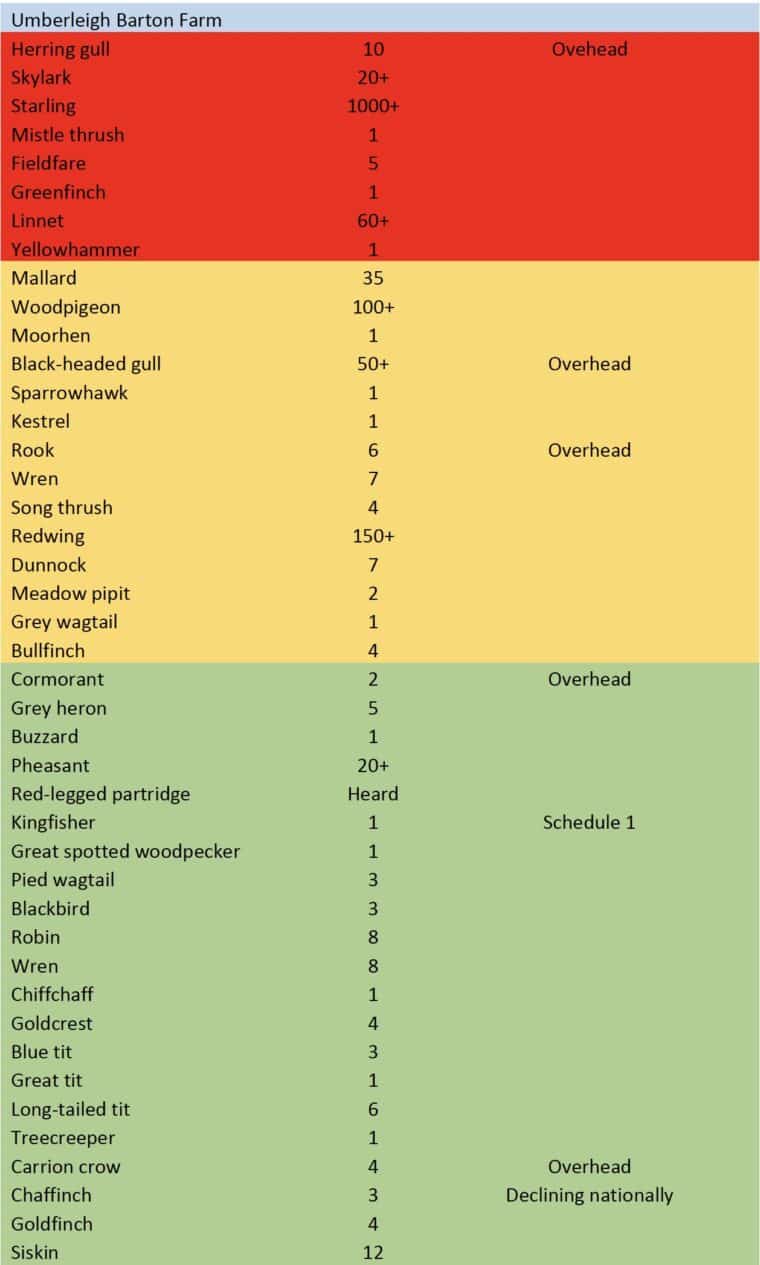
Table 1: A summary of the bird species recorded on or over Umberleigh Barton Farm (willow crop). Red = red listed; orange = amber listed; green = green listed.
Willow Crop
The willow crop and surrounding habitat (within 250 metres) supported 38 species (Table 1 and Figure 1). A further five species flew overhead and were not using the immediate habitat (black-headed gull, herring gull, cormorant, carrion crow and rook). Eleven species were seen or heard in the willow crop included wren, song thrush, blackbird, great tit, blue tit, goldcrest, long-tailed tit, robin, dunnock, siskin and chiffchaff. These species appeared to be penetrating the mixed age willow and could be seen or heard moving deep (10 metres and beyond) into the crop. For example, a flock of long-tailed tits came out from the willow crop and heading into a woodland copse by the railway and song thrushes could be heard calling from deep within the willow. A flock of siskins circled overhead and came down to the tops of the older, mature willow stems. At dusk, 60+ linnets perched on the telegraph wires above one-year old willow stems and dropped down to rest for the night (roost). The adjacent stubble and winter-crop fields had a slightly different suite of bird species compared to the willow crop and the hedgerows. A flock of over 1,000 starlings were feeding in the stubble field by the willow crop and a flock of skylarks were occasionally rising up from this and other nearby fields. The pastoral, grassy fields to the west of the crop were largely devoid of any birdlife.
Miscanthus Crop
The miscanthus crop supported fewer species and the majority of the 28 species recorded were using the adjacent hedgerows, woodland and grassland habitats (see Table 2 and Figure 2). However, nine species were seen using the crop: wren, pied wagtail, song thrush, blackbird, reed bunting, goldcrest, meadow pipit, long-tailed tit and redwing. Most were on the edge of the miscanthus, flying into or out of the crop, presumably looking for food. For example, two goldcrests were foraging in the ancient hedgerow and then flew across to the miscanthus. Wrens and robins were generally crossing between the hedgerow or field margins and spending time on the edge of the miscanthus. At dusk on the second survey for this site over 1,000 pied wagtails flew into roost in one area of the miscanthus. This was situated on a lower slope closer to the farm buildings (see Figure 2). They appeared in flocks – often ten to 20 birds – over a 40-minute period (3:50pm to 4:40pm). A small number of redwings (6+) also appeared to drop down into the miscanthus. Overall, birds seen during the surveys were mostly using the miscanthus, the hedgerows and the patches of woodlands. The pastoral, grassy fields were largely devoid of birdlife aside from the occasional meadow pipit, blackbird or robin, and a stonechat that was moving from fencepost to fencepost by the miscanthus crop.
Discussion
The overall number of individuals (abundance) and diversity of species (richness) of birds differed between the two locations, although both crops supported large numbers of roosting birds – the young willow crop was used by linnets and the miscanthus was used by pied wagtails (and to a lesser degree redwings and reed buntings).
Umberleigh Barton Farm (willow) had a more diverse range of bird species, probably complemented by the mixed farming environment surrounding the willow. It formed part of a continuous mosaic environment. The corridor of trees and scrub along the railway line, hedgerows and stubble fields are complemented by the willow and allow birds to extend their foraging into it. The different stages of willow crop also replicate similar features to traditional coppicing methods that were once abundant across Britain and benefit a range of wildlife (Fuller & Warren 1993, Anderson et al. 2004). Overall, it appeared the willow crop was providing an additional habitat to what was already there and supporting woodland/hedgerow birds. The adjacent stubble and winter-crop fields were occupied by a small number of species – namely starling, skylark and a kestrel – which did not use the willow crop (although skylarks will use willow plantations after they have recently been cut (Sage et al. 2006)). Sage et al. (2006) also found that hedgerows adjacent to a willow crop contained more bird species than hedgerows adjacent to arable crops or grassy fields.
In comparison, Langaller Farm (miscanthus) had a smaller range of bird species, with most of the birds being concentrated in the field edges along the ancient hedgerows and adjacent woodland. This may be because the non-native crop provides less food for birds (Bellamy et al. 2009); examination of the stems and leaves of the miscanthus did not show any damage from insects feeding on it. A study in Ukraine shows that some insect populations – such as aphids, leafhoppers and thrips – are supported by miscanthus (Stefanovska et al. 2017), while another study in the UK shows that where other plants are able to grow in miscanthus plantations – after cropping and in earlier stages of growth – they support higher populations of invertebrates compared to other crops such as reed-canary grass (Semere & Slater 2007). Spiders may still use the stems for making webs and at ground level there are likely to be ground invertebrates such as beetles, slugs, snails, springtails and other soil inverts, although miscanthus supports lower populations of invertebrates – such as spiders, harvestmen and ground beetles – compared to mixed-use arable fields (Williams & Feest 2019). A study by Sage et al. (2010) shows that bird populations can be variable depending on the how the miscanthus grows and whether there are patches of other plants growing (that provide more food for birds). The lower bird abundance and richness in this crop may also be down to the geography of the location. The farm is 180 metres above sea level and many birds may have moved to lower ground where there is more food and slightly warmer temperatures. Despite this lower abundance, it was apparent that while the adjacent pastoral meadows were largely devoid of any birds, the miscanthus did have more birds, albeit concentrated along its edges.
Sage et al. (2010) found a largely neutral effect of miscanthus on woodland and farmland birds, although miscanthus crops often contained low numbers of birds. However, they did find unharvested miscanthus crops held more birds during winter, such as woodcock, blackbirds and reed buntings, compared to comparison plots (arable, grassland and short rotation coppice willow), although there was a lot of variability between the latter. Bellamy et al. (2009) also found miscanthus to have a higher population of birds in winter compared to adjacent wheat crop fields.
The results of these winter ‘snapshot’ bird surveys suggest that while both types of crops support a variety of small birds, the way in which birds use them in late November differs. The willow appears to provide more feeding opportunities throughout its structure, although particularly in the areas two years old or more. They provide gaps for light to reach the ground level and allow a herb-bramble-nettle layer to grow, providing more feeding and nesting opportunities for birds. The miscanthus meanwhile creates favourable cover for roosting pied wagtails and feeding opportunities along its margins. The mature miscanthus develops a thick sward which allows less light to penetrate to the ground level and therefore fewer opportunities for other plants to grow. In some places, where the soil is thin, the miscanthus grows shorter and in patches, allowing shorter, native grasses and other plants to grow. This is likely to be more attractive to invertebrates and feeding birds.
Limitations
The dawn and dusk visits were single, one-off winter visits that provide a snapshot of what is using each crop. We will be repeating the visits in the spring and summer to see how the crops compare. More regular, monthly surveys would need to be conducted to monitor bird populations more accurately over time.
Recommendations
The miscanthus will continue to provide roosting habitat for the pied wagtails until the spring. The birds will start to disperse in March as they take up territory ready for the breeding season. Cutting the miscanthus in April should miss the period in which the birds are using it as a roost (although may affect anything trying to nest in it).
The mixed-age willow will continue to provide roosting habitat for the linnets and the birds are likely to move around as the crop is cut on rotation providing different aged growth, some of which will be to their liking.
Conclusion
The bird surveys conducted at the two farms have provided valuable information about the bird populations in the two areas. The results illustrate how more regular surveys would build a more detailed picture of what and how birds use these crops and how they differ over seasons and years. These in turn can inform and support decisions on how these crops can support nature recovery, carbon sequestration and their use as biofuels.
Photo Credits
Photo credits for Figure 1 and 2
Photos from Flickr (CC BY 2.0): chaffinch by Alan Cleaver; chiffchaff, great spotted woodpecker, house sparrow, long-tailed tit, siskin, stonechat, treecreeper and wren by Caroline Legg; stock dove by Frank Vassen; reed bunting by Gérard Meyer; kestrel by Hari K Patibanda; woodpigeon by Ian Preston; skylark by Imran Shah; goldcrest by Jo Garbutt; kingfisher by Joe M Devereux; sparrowhawk by John Freshney; bullfinch and greenfinch by Luiz Lapa; dunnock and linnet by Nick Goodrum; grey wagtail by Nigel Hoult; meadow pipit by Ron Knight; mistle thrush by Sudge 9000. Photo from Flickr (CC0): pied wagtail by Wildlife Terry. Photo from Pexels: Redwing by Denitsa Kireva; Chaffinch by Phil Mitchel. Other photos: mallard, moorhen and starling by Ed Drewitt.
Satellite images used courtesy of Bing Maps.
References
Anderson, G. Q., Haskins, L. R. & Nelson, S. H. (2004). The effects of bioenergy crops on farmland birds in the United Kingdom: a review of current knowledge and future predictions. In: Biomass and Agriculture: Sustainability, Markets and Policies (eds: K. Parris & D. Poincet). Organization for Economic Cooperation and Development, Paris, France, 572, 199-218.
Bellamy, P. E., Croxton, P. J., Heard, M. S., Hinsley, S. A., Hulmes, L., Hulmes, Nuttall, P., Pywell, R.F. & Rothery, P. (2009). The impact of growing miscanthus for biomass on farmland bird populations. Biomass and Bioenergy, 33(2), 191-199.
Bright, J. A., Anderson, G. Q., Mcarthur, T., Sage, R., Stockdale, J., Grice, P. V. & Bradbury, R. B.(2013). Bird use of establishment-stage Miscanthus biomass crops during thebreeding season in England. Bird Study, 60(3), 357-369.
Donnison, C., Holland, R. A., Harris, Z. M., Eigenbrod, F. & Taylor, G. (2021). Land-use change from food to energy: Meta-analysis unravels effects of bioenergy on biodiversity and cultural ecosystem services. Environmental research letters, 16(11), 113005.
Fry, D. A. & Slater, F. M. (2011). Early rotation short rotation willow coppice as a winter food resource for birds. Biomass and Bioenergy, 35(7), 2545-2553.
Fuller, R. J. & Warren, M. S. (1993). Coppiced woodlands: their management for wildlife. Peterborough: Joint Nature Conservation Committee.
Sage, R., Cunningham, M. & Boatman, N. (2006). Birds in willow short‐rotation coppice compared to other arable crops in central England and a review of bird census data from energy crops in the UK. Ibis, 148, 184-197.
Sage, R., Cunningham, M., Haughton, A.J., Mallott, M.D., Bohan, D.A., Riche, A. & Karp, A., 2010. The environmental impacts of biomass crops: use by birds of miscanthus in summer and winter in southwestern England. Ibis, 152(3), 487-499.
Semere, T. & Slater, F. M. (2007). Ground flora, small mammal and bird species diversity in miscanthus (Miscanthus× giganteus) and reed canary-grass (Phalaris arundinacea) fields. Biomass and Bioenergy, 31(1), 20-29.
Stanbury, A., Eaton, M., Aebischer, N., Balmer, D., Brown, A., Douse, A., Lindley, P., McCulloch, N., Noble, D. & Win, I. (2021). The status of our bird populations: the fifth Birds of Conservation Concern in the United Kingdom, Channel Islands and Isle of Man and second IUCN Red List assessment of extinction risk for Great Britain. British Birds, 114, 723-747.
Stefanovska, T., Pidlisnyuk, V., Lewis, E. & Gorbatenko, A. (2017). Herbivorous insects diversity at miscanthus× giganteus in Ukraine. Agriculture (Pol’nohospodárstvo), 63(1), 23-32.
Williams, M.A. & Feest, A. (2019). The effect of Miscanthus cultivation on the biodiversity of ground beetles (Coleoptera: Carabidae), spiders and harvestmen (Arachnida: Araneae and Opiliones). Agricultural Sciences, 10(7), 903-917.
Williamson, K. & Homes, R. C. (1964). Methods and preliminary results of the Common Birds Census, 1962–63. Bird Study, 11(4), 240-256.
On Location at the Bird Survey – Videos
Latest Technical Articles
Report: Biomass Connect Industry Panel Consultation Report
In April 2023, Biomass Connect held a stakeholder consultation workshop with experts from the biomass industry to better understand the key challenges currently facing the industry and how these could best be addressed by the programme. This first industry workshop was predominantly attended by stakeholders from academia and consultants working in biomass related sectors.
The resulting Consultation Workshop Report identified the main challenges for the industry, the major opportunities and made recommendations to Biomass Connect on how to improve its continued support of the industry. The report took the comments and core points from the workshop, expanded on them and took into consideration other factors to provide a fuller picture to a broader audience.
We thank those who took part in the Industry workshops and will be arranging further community expert workshops soon.









